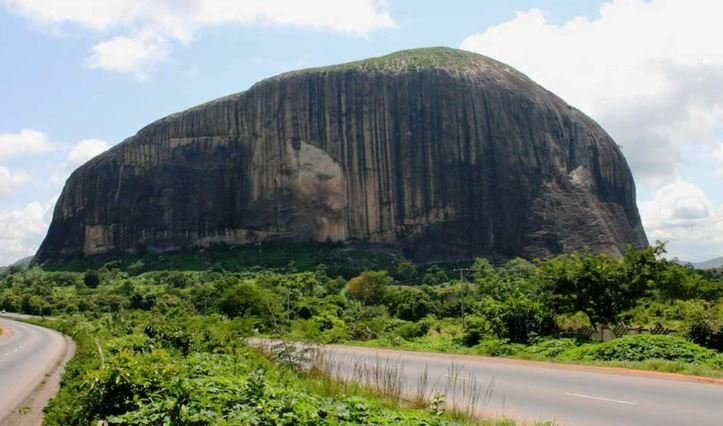
Top 10 Landmarks In Nigeria And Their Location
This is the list of Nigeria’s top 10 famous landmarks, and their location:
READ ALSO: 10 Largest Churches Auditorium In Nigeria (2025)
| No | Landmark | Location |
|---|---|---|
| 1 | Zuma Rock | Abuja, Niger State |
| 2 | Olumo Rock | Abeokuta, Ogun State |
| 3 | The National Arts Theatre | Iganmu, Lagos |
| 4 | The Walls of Benin | Benin City, Edo State |
| 5 | Sungbo’s Eredo | Ijebu-Ode, Ogun State |
| 6 | Aso Rock | Asokoro, Abuja |
| 7 | Shere Hills | Jos, Plateau State |
| 8 | Ogbunike Caves | Ogbunike, Anambra State |
| 9 | Cross River National Park | Cross River State |
| 10 | Yankari Game Reserve | Bauchi State |
1. Zuma Rock – Abuja, Niger State

Zuma Rock is a famous natural landmark in Nigeria, located in Madalla, a town in Niger State, close to the capital city of Abuja.
This huge rock, made of igneous materials like gabbro and granodiorite, stands about 300 meters (980 feet) tall, making it taller than both Aso Rock and Olumo Rock combined.
It is often called the “Gateway to Abuja from Suleja” and is even featured on Nigeria’s 100 Naira note. The rock was first discovered in the 15th century by the Zuba people, who called it “zumwa,” meaning “a place of guinea fowls.”
Local legends say Zuma Rock is a protective guardian deity for the Gwari people living nearby. It is believed to have spiritual powers, and some claim it can heal illnesses.
Zuma Rock is surrounded by many stories, including tales of unseen spirits and mysterious happenings. There was once a village nearby where sacrifices were made to honor a deity associated with the rock.
2. Olumo Rock – Abeokuta, Ogun State
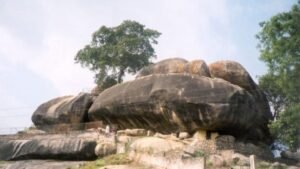
Olumo Rock is a popular mountain located in Abeokuta, the capital city of Ogun State in southwestern Nigeria. It is one of the most popular tourist attractions in the country and holds notable historical and cultural value.
Historically, Olumo Rock served as a natural fortress for the Egba people during inter-tribal wars in the 19th century. It’s believed that It provided protection and a safe hiding place for them.
From the top of the rock, the Egbas could monitor enemy movements, giving them an advantage in battles. Standing at 137 meters above sea level, Olumo Rock offers visitors stunning views of the city of Abeokuta, whose name means “under the rock” in Yoruba. The site is also considered sacred, as its patron spirit is venerated in the Yoruba religion.
Olumo Rock is a must-visit destination for anyone interested in Nigeria’s history, culture, and natural beauty. It tells the story of survival, strength, and heritage while offering an unforgettable experience to all visitors.
READ ALSO: List Of All Ministers Of State Education In Nigeria (2023-Present)
3. The National Arts Theatre – Iganmu, Lagos

The National Arts Theatre in Iganmu, Lagos, is a major landmark in Nigeria and the country’s main center for performing arts. Built to resemble a military hat, it shares its architectural design with the Palace of Culture and Sports in Varna, Bulgaria, but is four times larger.
Construction started during General Yakubu Gowon’s military regime and was completed in 1976 under General Olusegun Obasanjo, just in time for the 1977 Festival of Arts and Culture (FESTAC).
The theatre has a 5,000-seat main hall with a collapsible stage, two cinema halls, and facilities for simultaneous translation into eight languages. In July 2024, President Bola Tinubu renamed it in honor of Nobel Laureate Professor Wole Soyinka.
The National Theatre has been managed by different teams and has faced controversies, including plans for privatization and a reported sale in 2014. It has appeared in popular media, such as Beyoncé’s Black is King and Burna Boy’s Grammy-winning performance in 2021.
4. The Walls of Benin – Benin City, Edo State
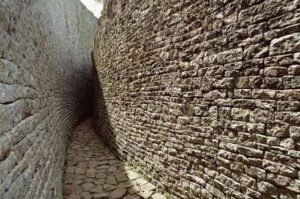
The Walls of Benin, also called the Benin Moat or Iyanuwo, are a group of massive earthworks in Benin City, Edo State, Nigeria. These structures date back to around 800 AD, and construction continued until about 1460 AD.
They were built manually, with soil from the inner ditch used to create the outer walls. Some believe the walls once stretched about 16,000 kilometers and enclosed 6,500 square kilometers of land, but only small parts remain today.
The walls and moats were built for defense, with steep banks and gates to control access. Invaders found it hard to cross the walls because of their height and the sharp slopes.
Also, the walls were used to mark boundaries and protect key areas like the royal palace. Unfortunately, the walls have suffered damage from urban growth, land disputes, and pollution.
Still, they remain an important part of Nigerian history and were once recognized by the Guinness Book of World Records as the second-largest man-made structure, after the Great Wall of China.
5. Sungbo’s Eredo – Ijebu-Ode, Ogun State

Sungbo’s Eredo is a large system of walls and ditches near the Yoruba town of Ijebu-Ode in Ogun State, southwest Nigeria. It was built between 800 and 1000 AD in honor of Oloye Bilikisu Sungbo, a noblewoman of the Ijebu people.
This site is recognized for its historical and cultural value and is on Nigeria’s tentative list of potential UNESCO World Heritage Sites. The fortifications are over 160 kilometers long, with ditches and banks forming an uneven ring around the old Ijebu Kingdom.
That said, the ditch can reach a height difference of 20 meters between its bottom and the bank. Also, the walls are surrounded by trees, giving the area a natural “green tunnel.”
Legends say the Eredo was built as a memorial to Bilikisu Sungbo, believed by some to be the Queen of Sheba mentioned in the Bible and Quran. Pilgrims visit her supposed grave annually in the nearby town of Oke-Eiri. Archaeologists suggest the Eredo had defensive purposes and symbolized unity among different communities.
In 1999, British archaeologist Patrick Darling helped bring attention to the site. In 2017, Ade Olufeko’s team renewed interest in the Eredo through research and mapping.
READ ALSO: List Of 10 Best Universities In Eastern Nigeria
6. Aso Rock – Asokoro, Abuja
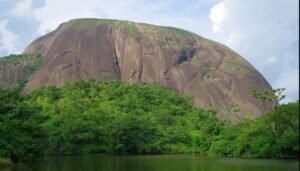
Aso Rock is one of the top landmarks in Nigeria. It is a giant granitic rock located at the edge of Abuja, the capital of Nigeria. Standing at 400 meters (1,300 feet) high, it is a prominent natural feature that reaches a peak height of 936 meters (3,071 feet) above sea level.
The name “Aso” means “victorious” in the local language of the Asokoro people, who are known as the “people of victory.” Aso Rock is not only a natural wonder but also holds great historical and political importance.
It is surrounded by key government buildings like the Nigerian Presidential Complex, the National Assembly, and the Supreme Court. Most of Abuja city stretches south of this iconic rock.
In 1991, when Nigeria’s capital was moved from Lagos to Abuja, Aso Villa was established near the rock under President Ibrahim Babangida’s administration. The villa includes offices for the President and Vice President, meeting rooms, and spaces for official functions.
It also has a mosque, a chapel, and a café to meet social and religious needs. Aso Rock was also the site of the 2003 Aso Rock Declaration during the Commonwealth Heads of Government Meeting (CHOGM).
7. Shere Hills – Jos, Plateau State
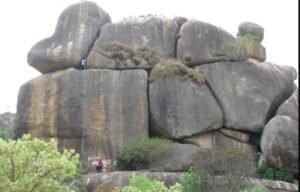
The Shere Hills are a beautiful range of hills and rock formations located on the Jos Plateau in Plateau State, Nigeria. These hills are about 10 kilometers east of Jos, the state capital, in the Middle Belt region of the country.
The Shere Hills are known for their unique landscapes, making them one of the top landmarks in Nigeria. However, the Shere Hills are famous for their high peaks.
The tallest peak in the range rises to about 1,776 meters (5,827 feet) above sea level, which makes it the highest point on the Jos Plateau. It is also the third-highest point in Nigeria.
The only places higher are Chappal Waddi on the Mambilla Plateau, which reaches 2,419 meters (7,936 feet), and Mount Dimlang (Vogel Peak) on the Shebshi Mountains, standing at 2,042 meters (6,699 feet).
Tourists and nature lovers visit the Shere Hills for hiking, camping, and enjoying the breathtaking views of the surrounding area. It’s a perfect spot for adventure and relaxation.
8. Ogbunike Caves – Ogbunike, Anambra State
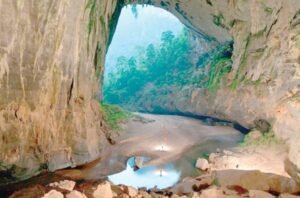
The Ogbunike Caves are in Ogbunike, Anambra State, in southeastern Nigeria. These caves are surrounded by a beautiful valley covered in tropical rainforest.
For many centuries, local people have considered the caves sacred, and they hold an annual celebration called “Ime Ogba” to honor the discovery of the caves. To reach the caves, visitors must climb 317 steps, built by the state government in the 1990s.
According to tradition, everyone must remove their shoes before entering. The main cave is large, with a high chamber at the entrance measuring about 5 meters tall, 10 meters wide, and 30 meters long.
Inside, there are ten tunnels leading to other chambers and smaller tunnels, some of which are connected. The caves are home to many bats, streams, and pools of water.
A stream from the caves flows into the Nkissa River, where warm and cold water meet. Visitors can relax in a flat area by the river. The caves are surrounded by 20 hectares of rainforest, protecting them from human activity.
READ ALSO: List Of All Ministers Of Education In Nigeria (1958-Present)
9. Cross River National Park – Cross River State
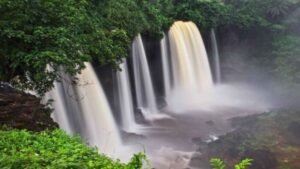
The Cross River National Park is a remarkable natural landmark in Nigeria, located in Cross River State. It is a national park divided into two sections: the Oban Division, established in 1988, and the Okwangwo Division, created in 1991.
Spanning approximately 4,000 km², the park is known for its lush tropical rainforests in the northern and central parts and mangrove swamps along the coast.
It is part of the Guinea-Congolian region, characterized by tall, emergent trees that rise as high as 40-50 meters. The park is a biodiversity hotspot and home to one of Africa’s oldest rainforests.
It shares a border with Korup National Park in Cameroon, forming the largest rainforest block in Nigeria. Rare and endangered species thrive there, like the Cross River gorilla, common chimpanzees, drills, and numerous bird species.
The park is also recognized as an Important Bird and Biodiversity Area, with over 350 bird species recorded, some of which are unique to the region.
10. Yankari Game Reserve – Bauchi State
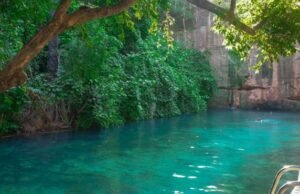
Yankari Game Reserve is located in Bauchi State, Nigeria, and is one of the country’s most popular wildlife parks. It has an area of about 2,244 square kilometers and is home to many different animals and plants.
The reserve is known for its warm water springs, which attract both wildlife and visitors. However, the park was first created in 1956 as a game reserve and later became a National Park in 1991.
Yankari is home to over 50 species of mammals, including African elephants, baboons, lions, and waterbucks. It also has more than 350 species of birds, such as the saddle-billed stork and the African grey hornbill. The park is a popular eco-tourism destination in West Africa and promotes wildlife conservation.
Some notable features of the park are the Wikki Warm Springs, Kalban Slope, and Tonlong Canyon. While the climate can be hot during certain months, Yankari remains a top spot for nature lovers and those interested in wildlife.


